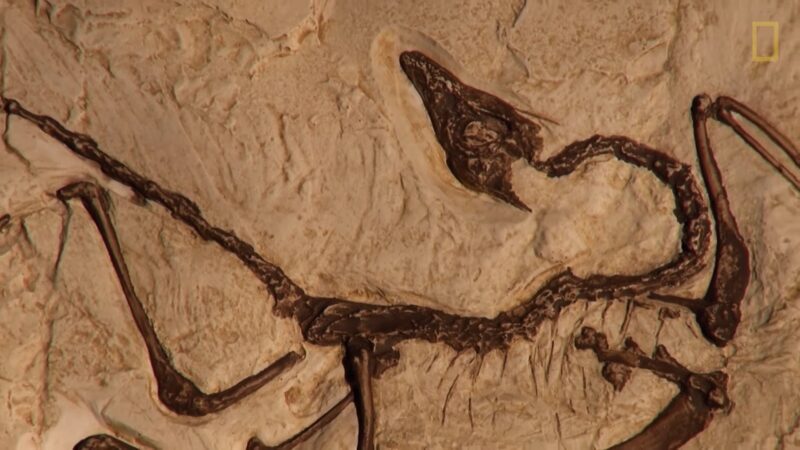In an unexpected twist to the annals of paleontology, a discovery in Uttarakhand, India, has left scientists scratching their heads. An abandoned subway station, untouched for over three decades, has become the epicenter of a mystery that challenges our understanding of prehistoric life.
An abandoned subway station in Uttarakhand, India, usually wouldn’t be the place you’d expect groundbreaking paleontological discoveries. Yet, here we are, with a find that might rewrite chapters of our prehistoric textbooks.
The discovery? A half-preserved corpse that bears an uncanny resemblance to a raptor-like dinosaur.
The Unearthly Discovery
According to local reports, the discovery was made by an electrician. While cleaning the long-abandoned station, he stumbled upon a partially preserved skeleton. What’s baffling is that this skeleton wasn’t just bones.
Some of its flesh was still intact. Given the timeline of dinosaur extinction, this find seems impossible.
- Location: Abandoned subway station in Uttarakhand, India.
- Discoverer: An electrician.
- State of the Corpse: Partially preserved with some flesh intact.
Expert Opinions
While the discovery has caused a stir among locals and the global community alike, experts are approaching it with caution. Aaryan Kumar, a PhD student in Paleontology from Delhi University, shared his insights:
“Non-avian dinosaurs have been extinct for the past 65 million years but it does resemble theropods, a suborder of dinosaurs which included bipedal carnivores. But a dinosaur skeleton could not have been found in such a well-preserved condition after millions of years without it being in a fossilized state. The only even slightly possible way is it was chemically preserved to store it in a museum. But if that was the case, how did it end up here?”
Possible Explanations
With the scientific community abuzz with theories and speculations, let’s delve into some of the most plausible explanations for this enigmatic find.
A Masterful Hoax?
The first and most skeptical theory is that this might be a well-crafted hoax. Perhaps someone with a flair for the dramatic and a deep understanding of paleontology planted this “corpse” to capture the world’s attention.
- Pros: It would explain the well-preserved state of the corpse.
- Cons: Experts have deemed it worthy of carbon dating, suggesting its authenticity.
A Modern-Day Ancestor
Another theory, and perhaps more plausible, is that this creature might be a modern-day ancestor of the dinosaurs. It could have been prepared for a museum display and somehow ended up in the abandoned station.
- Evidence: Dinosaurs never truly went extinct. Many evolved into birds, as we know them today.
- Supporting Fact: Many birds have skeletons resembling those of dinosaurs.
A New Species?
Could it be that this creature is a hitherto unknown species? If it’s a recent discovery, its preservation might explain its dinosaur-like appearance after partial decay.
- Pros: It would be a monumental discovery, bridging gaps in our understanding of evolution.
- Cons: More research and evidence are needed to support this claim.
The Bird-Dinosaur Connection

The link between birds and dinosaurs isn’t new. Many paleontologists believe that birds are the direct descendants of theropod dinosaurs. This discovery might just be the missing piece in this evolutionary puzzle.
Birds: The Living Dinosaurs
It’s fascinating to think that the birds we see every day are descendants of the mighty dinosaurs. Their skeletal structures, especially of certain species, bear a striking resemblance to their prehistoric ancestors.
- Evidence: The biomechanics behind Theropods, as illustrated by Jay Rasgorshek, showcases this connection.
- Fact: Theropods were a suborder of dinosaurs that included bipedal carnivores.
Evolutionary Implications
If this discovery is indeed a missing link between birds and dinosaurs, it could revolutionize our understanding of evolution. Both dinosaur enthusiasts and birdwatchers would have a field day with such a revelation.
- Pros: It would provide invaluable insights into the evolutionary journey from dinosaurs to birds.
- Cons: It’s still too early to draw definitive conclusions.
Final Thoughts
The discovery in Uttarakhand has undoubtedly stirred the waters of the scientific community and the public alike. It serves as a poignant reminder of the mysteries our planet still holds, waiting to be uncovered.
Whether this finding turns out to be a relic from the past, a bridge to our evolutionary journey, or a mere hoax, it has already achieved something significant: reigniting our collective curiosity and wonder about the natural world. As we await further research and conclusive evidence, one thing is certain: our quest for understanding the intricate tapestry of life on Earth is far from over.
Here’s to the endless pursuit of knowledge and the surprises it brings along the way.














